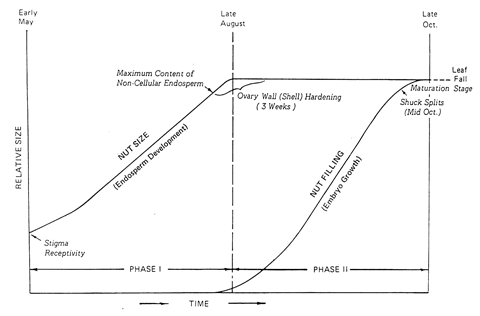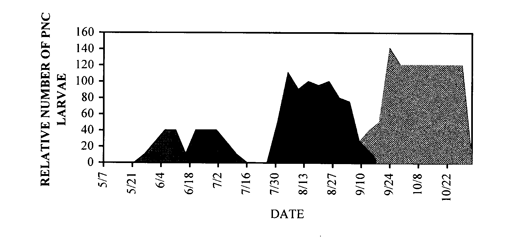Guide H-650
By Esteban Herrera, Brad E. Lewis
College of Agriculture Consumer and Environmental Science, New Mexico State University
Authors: Respectively, Extension Horticulturist, Research Entomologist both of Department of Department of Entomology, Plant Pathology, and Weed Science, both of New Mexico State University (Print Friendly PDF)
Environmental conditions, management inputs, and pest pressure all have direct impacts on pecan yield or nut quality. In many instances, the physiological stage of the pecan nut determines if a specific adversity (environmental, management, pests) will result in reductions in yield, quality, or both.
This guide covers the development of a pecan nut throughout the season and how it relates to potential damage by pecan nut casebearer. Because of uncertainty related to third-generation PNC damage in New Mexico pecan orchards, a brief discussion on possible damage is included.
Pecan Nut Development in the Mesilla Valley
Nut production begins with the onset of flowering. Pollen shed from catkins (male flowers) generally is abundant every year. Female flower structures may be present in adequate numbers or they may be scarce if the crop was exceptional the previous year and alternate bearing is taking place in the orchard.
Pollination is the first stage in the development of a pecan nut. The remaining stage can be subdivided into two major phases, I and II. Because of variations in environmental conditions, it is difficult to place an exact date on the initiation or completion of phases or stages of nut development.
Phase I begins at pollination (early to mid-May) and lasts until the initiation of shell hardening (mid-August). During this 90-day period, nuts enlarge to their final size. A period of fast nut growth starts about mid-July and ends in late August. Liquid content inside pecans makes irrigation management critical in pecan orchards during this time. Maximum water stage (content) occurs from mid-August to the end of August (fig. 1). During this stage, nut drop could dramatically intensify due to water stress.

Figure 1. Relative nut growth rates and average nut development stages for ‘Ideal’ (‘Bradley’) and Western Schley’ pecans in the Mesilla Valley, New Mexico.
Phase II begins at shell hardening and concludes at nut maturation in late October. During this six-week period, kernel development and nut filling occurs. During phase II, the liquid within the kernel begins to thicken (thus the name “gel stage”) around the third week in August.Approximately 7 to 12 days after the initiation of the gel stage, the dough stage begins. The dough stage is characterized by the absence of liquid or gelatinous material within the nut. Nut maturity soon follows with the splitting of the four sutures on the hull and exposure of the shell. Moisture in the nut may drop from 30 to 12 percent during this period. Release of the nut from the dried shuck depends on climatic factors and on the nut shape. High environmental moisture and round nut shapes both contribute to increase in nut retention by the husk.
Pecan Nut Casebearer (PNC) in the Mesilla Valley
Pecan nut casebearer is not new to New Mexico pecan production. It has been a problem in the eastern pecan-growing region of the state for the past 30 years. Natural borders created by Franklin, Oregon, Sacramento, and Guadalupe Mountains and the vast expanse of nonirrigated desert have prevented its natural migration from the east to the western pecan-growing regions.
In 1988, pecan nut casebearer was found on homegrown trees in El Paso, Texas—the first time this pest was recorded in the western growing region. By 1994, PNC had moved north from El Paso to pecan-growing areas in New Mexico’s Mesilla Valley. Currently, PNC has established itself in over 70 percent of the pecan-producing areas in the western region of New Mexico. Within the next four years, it is estimated that PNC will establish in the majority of the remaining pecan acres.
Seasonal PNC moth activity in the western pecan growing regions of New Mexico, as monitored by pheromone traps, is found in fig. 2. Three distinct moth flights are evident. During 1988, the first flight began the middle of May, with moths emerging from the overwintering larval population. The second moth flight began in early July, with the third flight beginning toward the end of August.

Figure 2. Mean number of pecan nut casebearer moths for combined locations during 1998 in the Mesilla Valley, New Mexico.
Using pheromone trap results combined with basic information on PNC biology and field observations, a reasonable estimate of when PNC larvae are present can be obtained (fig. 3). Number of larvae (fig. 3) is relative to number of moths caught in pheromone traps and is not intended as an estimate of field populations. The value of fig. 3 is found in the estimated periods when PNC larvae were present during 1998.
Figure 3. Relative number of pecan nut casebearer larvae (extrapolated from pheromone trap results) for Mesilla Valley, New Mexico, 1998.
First-generation larvae began feeding on nutlets toward the end of May and continued feeding until the middle of July. Second-generation larvae began feeding in mid-July and continued until early September. By the time all second-generation larvae had completed development, third-generation larvae were present. During 1998, this generation overlap was particularly evident. Both late instar second-generation and early instar third-generation larvae were collected concurrently in ‘Western Schley’ pecan orchards.First- and early second-generation PNC feed during phase I of nut development. This phase represents the period from pollination or soon after to shell hardening. Crop damage by PNC larvae is restricted to yield reduction during this period. Larvae are able to feed through the husk tissue and into the interior of the nut. Nut damage results in the formation of an abscission layer within the peduncle, and the eventual dropping of the nut from the cluster. Depending on the nut load, first- and early second-generation PNC feeding may thin a heavy crop load or significantly reduce orchard yield potential.
Nut damage due to second- and early third-generation PNC larvae depends on the developmental stage of the nut (table 1).
| Table 1. Pecan nut development stages and corresponding pecan nut casebearer generations for western New Mexico pecans. | ||
| Dates (estimated) | Developmental stage | PNC generation |
| August 15 |
Hard shell stage begins </div class="center">
|
Second </div class="center">
|
| August 21 |
Nut fill begins; gel stage </div class="center">
|
Second </div class="center">
|
| September 1 |
Dough stage (no liquid) </div class="center">
|
Late second, early third </div class="center">
|
| September 7 |
Hard shell stage finishes </div class="center">
|
Late second, third </div class="center">
|
| October 7 |
Nut fill finishes </div class="center">
|
Third </div class="center">
|
| October 30 |
Nut maturity </div class="center">
|
Third + generation </div class="center">
|
Larval feeding prior to hard shell (mid-August) typically results in significant damage to the nut, formation of an abscission layer, and loss of the nut. It is important to remember that nuts develop at different rates. During the period of the pecan’s shell hardening (three weeks) a percentage of nuts are susceptible to yield loss caused by late second- and early third-generation PNC larvae. Crop loss during the late second generation can be particularly damaging to final yield. This period of time is after August drop, so affected nuts represent direct yield loss. Damaged nuts before August drop represent potential yield loss.
After completion of hard shell (early August), third-generation PNC dominate in southern New Mexico pecan orchards. Although PNC cannot penetrate the shell, larvae feed and tunnel freely within the husk, along the shell (grazing), and at the point of attachment between the husk and the peduncle. The nut filling process takes approximately six weeks in the Mesilla Valley and is usually complete by mid-October. During this period, nutrients and water move through the peduncle and husk and into the developing nut. Damage due to PNC feeding during this period does not normally result in a loss of a nut but can possibly reduce nut quality.
During the 1998 growing season, evidence of PNC larvae grazing along the exterior of the shell and feeding within the husks was prevalent in orchards with high third-generation larval populations. Of those nuts extensively fed on by third-generation larvae, a limited number exhibited quality problems directly associated with larval feeding. These problems manifested themselves either in the form of shriveled meats in a localized area or darkened meats directly below areas where shell grazing occurred.
Preliminary research conducted during 1998 indicates nuts are susceptible to significant reductions in meat quality only during a short period after shell hardening. If you consider the physiological processes occurring during phase II, limited reductions in quality due to extensive husk feedings is possible up to maturation. Although the impact on yield by third-generation PNC may be insignificant, the presence of dark or shriveled meat in a grade sample may bring a shipment down a grade.
It is apparent that at least in some years, all three generations of pecan nut casebearer can cause economic damage in New Mexico and other western region pecan orchards. Damage includes potential yield loss by first-, second-, and early third-generation larvae and potential reductions in quality by late second- and third-generation larvae.
Mistimed or no insecticide applications directed at economic levels of first- and second-generation larvae can contribute to late-season PNC generation overlap. Overlapping generations can result in more difficult timing of insecticide applications and an increase in the number of applications than when distinct generations are present. Pecan nut casebearer developmental stages can shift as many as 15 days from one year to the next. An effective monitoring program for PNC and nut development during late phase I and early phase II, combined with an effective suppression program, will help ensure minimum pecan yield and quality reductions due to late-season generations.
To find more resources for your business, home, or family, visit the College of Agricultural, Consumer and Environmental Sciences on the World Wide Web at pubs.nmsu.edu
Contents of publications may be freely reproduced for educational purposes. All other rights reserved. For permission to use publications for other purposes, contact pubs@nmsu.edu or the authors listed on the publication.
New Mexico State University is an equal opportunity/affirmative action employer and educator. NMSU and the U.S. Department of Agriculture cooperating.
July 2000, Las Cruces, NM


